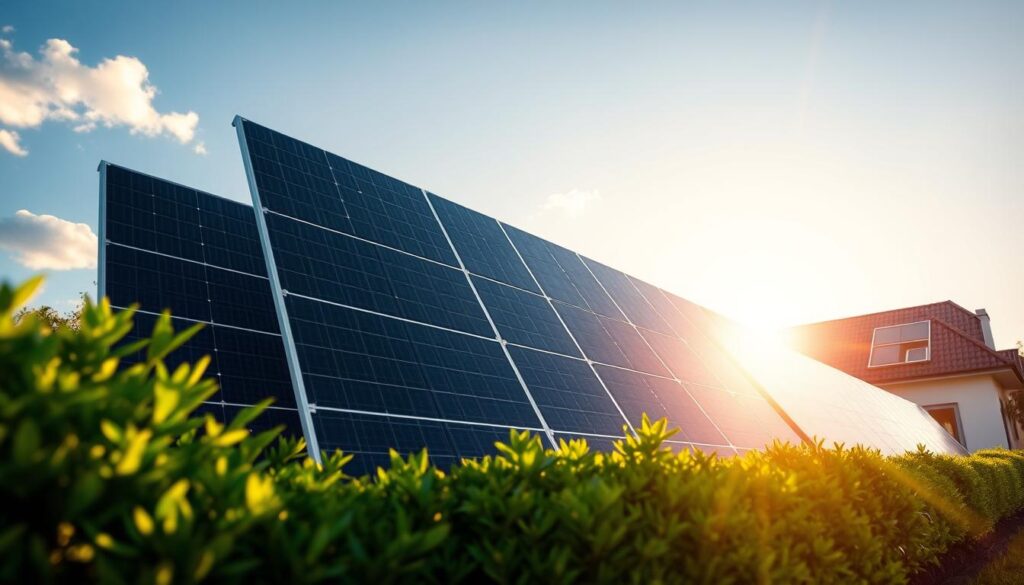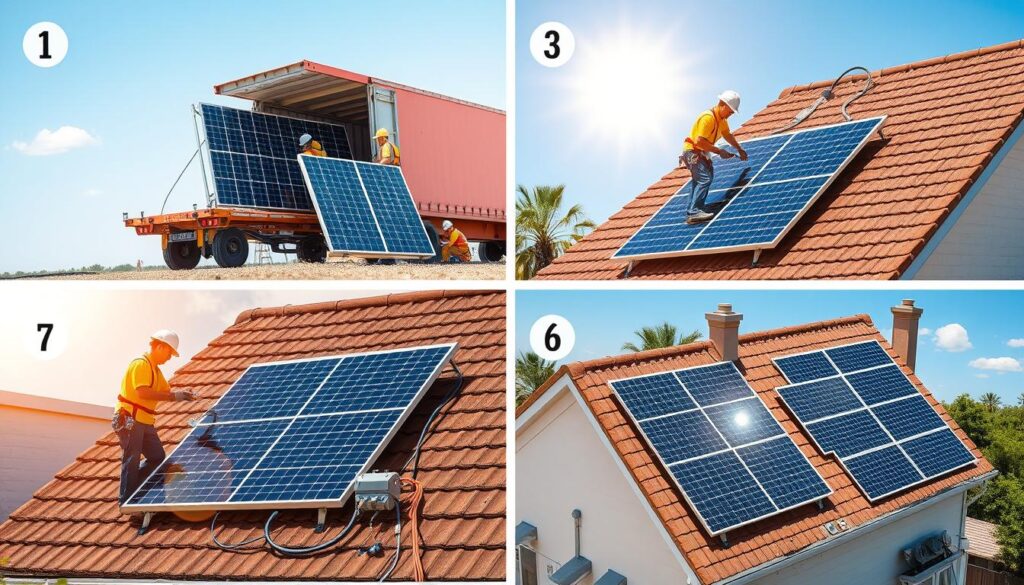Home solar panel systems are reshaping energy use across the U.S., with over a million installations nationwide. These residential solar energy solutions combine affordability and innovation, helping families save money while reducing their carbon footprint. From federal tax credits to state incentives, these systems are now within reach for more homeowners than ever before.
Modern solar technology converts sunlight into electricity, offering 25-year warranties and efficiency ratings over 20%. Incentives like the 30% federal tax credit and state programs like Colorado’s net metering policies make the switch to solar a smart financial move. With savings like $30 monthly bills for some households, solar energy is proving itself as a reliable, long-term investment.
Key Takeaways
- Over 1 million U.S. homes now use home solar panel systems to reduce energy costs.
- Federal tax credits cover 30% of solar installation costs through 2032.
- Colorado residents with solar systems can see bills drop to $30/month through net metering.
- Monocrystalline panels, the most common type, reach over 20% efficiency ratings.
- SEIA predicts 28% of solar systems will pair with batteries by 2028 as storage grows in popularity.
Understanding Home Solar Panel Systems
Home solar panel systems simplify how solar energy for homeowners becomes a reliable power source. These systems combine technology and sunlight to cut costs and reduce environmental impact. Let’s explore how they work and what they include.
In 90 minutes, the amount of sunlight that hits the Earth could supply the entire world with electricity for a year.
How Residential Solar Energy Works
- Solar panels use the photovoltaic effect to turn sunlight into direct current (DC) electricity.
- Inverters convert DC into alternating current (AC), used by home appliances).
- Excess energy flows to batteries or back to the grid for credits.
Key Components of a Home Solar Setup
- Solar panels: Capture sunlight to produce energy.
- Inverters: Convert DC to AC power.
- Mounting hardware: Secure panels to roofs or ground mounts.
- Battery storage: Tesla Powerwall or similar units store unused energy.
Companies like Qmerit have installed over 81,000 systems, ensuring seamless component coordination.
Grid-Tied vs. Off-Grid Systems
| Grid-Tied | Off-Grid |
|---|---|
| Connected to utility grid for night/daytime power balance | Independent system with no grid connection |
| Uses net metering for credit systems | Requires large battery banks for energy storage |
| Affordable option for most homeowners | Higher upfront costs but ideal for remote areas |
Grid-tied systems are favored by 90% of home solar panel systems users due to cost savings and reliability.
The Environmental Impact of Solar Power for Homes
Going solar isn’t just about saving money—it’s a powerful step toward protecting the planet. Residential solar systems slash greenhouse gases and offer broader ecological perks. Discover how the benefits of residential solar panels
Every rooftop with solar panels helps shrink the energy system’s footprint. From cutting pollution to curbing water waste, solar energy for homeowners builds a greener future—one panel at a time.
Financial Benefits of Installing Solar Panels
Investing in benefits of residential solar panels delivers long-term financial rewards. The federal tax credit now covers 30% of system costs, and homes with solar can sell for up to $15,000 more than non-solar homes. Over 25 years, savings often exceed $50,000, shielding households from rising utility rates.
- Monthly electric bills drop by hundreds of dollars.
- Solar systems pay for themselves in 5–15 years.
- Home equity grows as solar functions like a kitchen remodel.
Average savings vary by location. See top performers below:
| State | 25-Year Savings |
|---|---|
| California | $104,498 |
| Massachusetts | $94,587 |
| New York | $77,844 |
| New Jersey | $58,403 |
Affordable solar panel options exist through loans or leasing. The 30% tax credit stays in place until 2032, and many states add rebates. Even with upfront costs starting around $20,000 after credits, systems generate returns like a kitchen upgrade. Over time, solar energy cuts energy bills while building equity. The math adds up: lower payments today plus higher resale value tomorrow mean solar is a smart financial move for families.
Best Solar Panels for Home Use in 2023
Choosing the best solar panels for home use starts with matching your budget and energy goals. Modern advancements mean even cloudy regions can enjoy savings, with options like affordable solar panel options for every budget.

Top-tier monocrystalline panels lead in performance. Maxeon sets the standard with 22.8% efficiency and a 40-year warranty—15 years longer than most. At $3.05 per watt, their panels generate up to 21.16 W/sq ft, ideal for small roofs. REC Alpha Pure (22.6% efficiency) and Panasonic Evervolt (22.2%) follow closely, balancing cost and output.
- Canadian Solar’s TOPHiKu6: 22% efficiency at $2.99/watt, making them standout affordable solar panel options.
- Jinko Solar Tiger Neo: 22.5% efficiency for under $3.03/watt.
- JA Solar: 21.5% efficiency with a 30-year 87% production guarantee.
Thin-film tech suits unique roofs, offering flexibility but lower efficiency. Comparing warranties: Maxeon’s 40-year coverage vs. standard 25 years extends long-term savings. Degradation rates under 0.4% per year ensure steady output. Temperature coefficients matter too—Panasonic’s -0.24% outperforms others in heat.
Ask installers about warranties and climate adaptation. With options from $2.73/watt to $3.18/watt, every budget finds a solution. Prioritize panels that align with your region’s weather and roof space!
The Solar Panel Installation Process Explained
Installing solar power system installation for your home is a structured process that ensures seamless energy transition. Here’s what to expect:
- Site Assessment: Professionals evaluate your roof’s condition, sunlight exposure, and local regulations to design the best layout.
- Permitting: Your installer handles paperwork with local authorities, which can take 2–4 weeks depending on jurisdiction.
- Equipment Order: Solar panels, inverters, and mounting hardware are sourced based on your system’s design.
- Installation Day: Most home solar panel systems take 1–3 days to mount panels, wire inverters, and connect to your electrical panel.
- Final Checks: Inspectors verify safety and code compliance before your utility company activates the system.

Before work begins, schedule a home energy audit to optimize system sizing. Installers will ensure panels are angled for maximum sunlight and connected securely. Once installed, a utility company will swap your meter to track energy production and consumption.
After inspection approval, your system is activated, and you’ll begin generating clean energy. Most components, like panels and inverters, come with 25–30 year warranties. Partner with certified installers to streamline the process and enjoy hassle-free solar power system installation. Regular maintenance via programs like Palmetto Protect keeps systems running efficiently for decades.
Federal and State Incentives for Home Solar Systems
Maximizing savings starts with understanding the financial support available. The home solar panel cost estimator can highlight how tax credits and rebates turn affordable solar panel options into reality. Let’s break down the savings:
Federal Tax Credits
Take advantage of the IRS Residential Clean Energy Credit. For systems installed by 2032, homeowners can claim 30% of installation costs as a tax credit. This includes solar panels, water heaters, and battery storage. For example, a $18,000 system with a $1,000 rebate qualifies for:
- 2023-2024: 30% credit = $5,100
- 2023 rebate example: $18,000 – $1,000 = $4,420 federal credit
The credit phases down to 26% in 2033 and 22% in 2034.
State-Specific Solar Incentives
States like New York offer 25% tax credits (up to $5,000) for solar systems. Combine this with federal savings: a $18,000 system in NY could save $8,190 through combined credits. Use a home solar panel cost estimator tool to compare state programs.
Utility Company Programs
Many utilities offer rebates for affordable solar panel options. Check for:
- Direct rebates (e.g., $2,500 for 6kW systems)
- Net metering agreements
- Loans with 0% interest
Solar Renewable Energy Certificates (SRECs)
“SRECs add income streams. A 6kW system in high-demand states can earn $200-400 annually.”
In states like NJ and MA, selling SRECs offsets costs further.
Act before deadlines—federal credits drop after 2032. Use the home solar panel cost estimator to see your state’s programs and maximize savings today.
Home Solar Panel Cost Estimator: What to Expect
Planning for solar energy starts with a home solar panel cost estimator. Today’s systems average $21,816 installed, but federal tax credits cut this by up to 30%. Tools like the home solar panel cost estimator help families see how incentives and state programs lower upfront costs. Many households qualify for affordable solar panel options starting under $15,000 after credits.
- A 5kW system costs $16,800 before incentives, dropping to $11,760 with tax credits.
- 10kW systems average $28,600 pre-tax credit, saving $8,580 with federal rebates.
- Battery storage adds $10k+, but 2023 tech cuts these costs 15% year-over-year.
“Solar payback periods now average 10 years—half the time of 2010 systems.”
Installation costs vary by roof type: asphalt shingle roofs save 15-20% vs. flat or metal roofs. Labor and permits make up 20% of total costs. Battery-free systems are cheaper, but affordable solar panel options often include 25-year warranties on panels. Maintenance stays low—most systems need only annual inspections and occasional inverter replacements after 10-15 years.
Use online calculators to input your home’s energy use. A 4kW system handles small homes using 10,000 kWh/year, while 8kW+ suits larger families. Compare quotes from installers using EnergySage or Google’s Project Sunroof tool.
Choosing the Right Solar Panel Company
Researching top-rated solar panel companies ensures your solar power system installation meets your energy goals. Start by verifying licenses and certifications like NABCEP, the industry’s gold standard. Look for installers with at least three years of residential solar experience.
“Just 1 hour of noon summer sun can meet the annual electricity demand of the entire US.”
Compare local and national companies using this guide:
| Feature | Local Companies | National Companies |
|---|---|---|
| Certifications | NABCEP-certified crews | May lack local expertise |
| Customer Service | Long-term support | Remote customer service |
| Financing | Custom payment plans | Lease options only |
| Warranty | 25-year equipment guarantees | May exclude tax credits |
- Verify warranties: Panels should have 25-year output guarantees
- Check reviews: Look for installers with BBB ratings above A-
- Compare quotes: Avoid offers below $2.60 per watt
Reputable brands like Qcells and Maxeon offer panels with 25-year warranties. Inverters from Enphase or SolarEdge should have at least 10-year coverage. Ask for references and inspect past projects. A trustworthy installer will include battery options like Tesla Powerwall in their proposals.
Maximizing Efficiency of Your Home Solar Power System
Boost your solar energy output and savings with smart strategies. Residential solar energy solutions work best when optimized for peak performance. Here’s how homeowners can get the most from their systems.
Optimal Panel Placement and Orientation
Location matters. In the U.S., face panels south for maximum sunlight. Shading cuts output, so keep panels clear of obstructions. Clean panels annually—dust can slash efficiency by 25%. Use a pro installer to assess your roof’s potential.
Battery Storage Solutions
Store unused energy with batteries. Tesla Powerwall or LG Chem models retain daytime energy for evening use. Pairing batteries with solar energy for homeowners reduces grid reliance and cuts bills. Choose a system matching your daily energy needs.
Smart Home Integration Options
Sync solar with smart tech. Smart meters track usage in real time. Apps let you shift appliance use to daylight hours. Microinverters balance panel performance, boosting overall efficiency by 5–10%.
| Factor | Action |
|---|---|
| Panel Cleaning | Schedule annual cleanings in low-rainfall areas |
| Battery Selection | Match storage capacity to daily energy use |
| Inverter Placement | Install in shaded spots to avoid overheating |
“Regular maintenance and smart tech adjustments can improve system output by up to 20%.” – Solar Energy Industries Association
Small changes yield big results. By combining these steps, solar users can enjoy 25–30% higher efficiency. Start today to turn sunlight into savings!
Conclusion: Powering Your Future with Solar Energy
Residential solar energy solutions are driving a clean energy revolution across American homes. Over 2 million U.S. households already use solar panels, slashing electric bills by up to 50% and adding $15,000 to home values. The benefits of residential solar panels extend beyond savings—each system avoids 3–4 tons of carbon yearly, matching the impact of planting 100 trees annually. With federal tax credits covering 30% of costs and state programs offering rebates, now is the best time to act.
Modern systems like the EcoFlow DELTA 2 battery store energy efficiently, ensuring power even during nighttime or storms. Solar technology continues improving, with costs dropping 55% since 2010. By 2030, prices could fall another 40%, making solar more accessible. Rising electricity rates and climate goals push 20 million more U.S. homes to adopt solar in the next decade. Systems last 25–30 years, locking in long-term savings against rising utility bills.
Explore your solar potential today. A free assessment from certified installers reveals how much you could save. With incentives available now and energy independence on the rise, making the switch means investing in both your wallet and the planet. Join the millions already harnessing the sun’s power—your home’s energy future starts with one call to a local installer.
